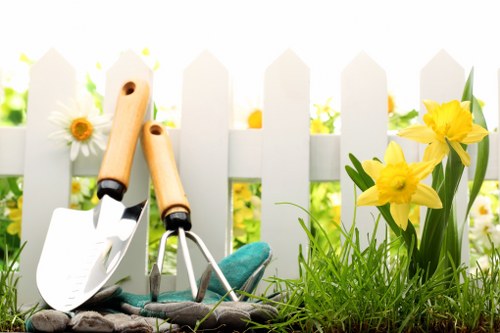Mastering Hedge Trimming in Chingford: A Comprehensive Guide

Hedge trimming is an essential aspect of maintaining the beauty and health of your garden in Chingford. Whether you're a seasoned gardener or a beginner, understanding the best practices for trimming hedges can make a significant difference in the appearance and longevity of your plants. In this article, we'll explore various techniques, tools, and tips to help you achieve perfectly trimmed hedges.
Hedges serve multiple purposes in a garden, including providing privacy, defining boundaries, and adding aesthetic value. Proper trimming not only enhances their appearance but also promotes healthy growth. In Chingford, where gardens often blend with picturesque landscapes, well-maintained hedges can elevate the overall charm of your outdoor space.
Before you start trimming, it's crucial to assess the type of hedge you have. Different plants require different trimming methods. For instance, evergreen hedges like boxwood and yew have specific needs compared to deciduous hedges like beech or hawthorn. Understanding the growth patterns and characteristics of your hedge will help you choose the right trimming approach.

Choosing the Right Tools for Hedge Trimming
Having the correct tools is fundamental to achieving a clean and precise trim. The most common tools used for hedge trimming include hedge shears, electric trimmers, and manual saws. Each tool has its advantages depending on the size and thickness of the hedge.
- Hedge Shears: Ideal for light trimming and shaping. They offer precise control for detailed work.
- Electric Trimmers: Suitable for larger hedges, providing efficiency and speed.
- Manual Saws: Best for thick or overgrown hedges where shears might not suffice.
Investing in high-quality tools will ensure that your trimming tasks are completed efficiently and with minimal effort. Regular maintenance of these tools, such as sharpening blades and ensuring proper functioning, is also essential for optimal performance.

Best Practices for Hedge Trimming
To maintain healthy hedges, it's important to follow best practices during trimming. Start by removing any dead or diseased branches to prevent the spread of issues. This not only improves the appearance but also promotes better air circulation within the hedge.
When trimming, aim for a uniform shape that complements the overall design of your garden. For tall hedges, it's typically recommended to trim them twice a year—once in late spring and again in late summer or early autumn. This schedule helps manage growth and maintains the desired height and density.
Additionally, avoid trimming hedges during extreme weather conditions. Dry, windy days can make trimming more challenging and increase the risk of introducing diseases. Opt for mild, dry days to ensure the best results.

Technique: Cutting for Optimal Growth
Proper cutting techniques are vital for the health and aesthetics of your hedges. Begin by establishing a clear guideline for the desired height and shape. Use a string line or a level to ensure consistency across your hedge.
Make clean, angled cuts to prevent water from pooling on the cut surfaces, which can lead to rot and disease. Position your hands on either side of the branch to apply even pressure, resulting in a straight cut.
For thicker branches, make the initial cut at an angle to reduce the risk of splitting. Follow up with a second cut closer to the base to remove the branch entirely.

Seasonal Hedge Trimming Tips for Chingford
Different seasons require different trimming approaches to align with the growth cycles of your hedges. In spring, focus on shaping and removing any winter damage. Summer trimming helps manage growth and maintain density, while autumn trimming prepares your hedges for the colder months by encouraging strong growth.
Winter is typically a resting period for most hedges, so minimal trimming is recommended unless necessary. However, it's a good time to inspect your hedges for any signs of disease or pest infestation and address them promptly.
By adapting your trimming routine to the seasons, you ensure that your hedges remain healthy and visually appealing throughout the year.
Common Mistakes to Avoid
Even experienced gardeners can fall into common pitfalls when trimming hedges. Over-trimming, such as cutting too much foliage at once, can stress the plant and hinder its growth. It's important to trim gradually, removing only a small portion of the hedge at a time.
Another mistake is neglecting the maintenance of trimming tools. Dull or poorly maintained tools can cause ragged cuts, leading to increased susceptibility to diseases. Regularly sharpen and clean your tools to maintain their effectiveness.
Lastly, avoid trimming hedges too late in the season, as new growth stimulated by late trimming may not harden off before winter, making it vulnerable to frost damage.
Enhancing Curb Appeal with Well-Trimmed Hedges
Well-trimmed hedges can significantly enhance the curb appeal of your home in Chingford. They serve as living fences that add structure and elegance to your garden, creating a welcoming environment for visitors.
Incorporate various types of hedges to add depth and texture to your garden design. Combining tall, dense hedges with lower, flowering varieties can create a visually appealing contrast that highlights the uniqueness of your outdoor space.
Regular trimming ensures that your hedges maintain their shape and proportion, contributing to a neat and organized garden layout. This not only boosts the aesthetic value but also increases the overall value of your property.

Hedge trimming in Chingford is more than just a gardening task—it's an art that requires knowledge, skill, and the right tools. By following the guidelines and best practices outlined in this article, you can achieve beautifully trimmed hedges that enhance the beauty and health of your garden. Invest time and effort into understanding your specific hedge needs, and enjoy the rewards of a well-maintained outdoor space.
